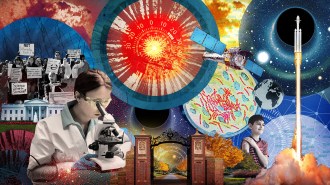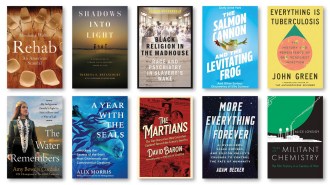To assemble a Top 10 list, Science News starts in June
By Nancy Shute
- More than 2 years ago
 When most people were thinking about summer vacation, we were contemplating the biggest science stories of 2018.
When most people were thinking about summer vacation, we were contemplating the biggest science stories of 2018.
Yep, it takes more than six months of effort to put together Science News’ annual issue on the Top 10 science stories of the year. 2018 was no different, though we were hit with some exciting twists that had us revisiting our decisions just a week or so before closing the issue.
The early discussions tend to be more about themes — climate emerged as a big one, even before the recent reports linking increased severity of hurricanes, floods and wildfires to climate change. Reporters lobby to get the stories that intrigued them the most or the discoveries that mark critical turning points onto the short list.
By August, our editors have identified contenders for the top of the list and are assigning stories so writers can get to work. We try to keep the choices under wraps; it’s part of the fun. All of the stories are assigned by October 1. By then, we’re also planning illustrations, graphics and bonus items, like our much-loved list of favorite science books of the year. By Thanksgiving, we’ve nailed down the “map” for the magazine, including story order and page designs.
And then news happens. This year was particularly rich in breaking news that had us reshuffling the deck. That included the discovery of an impact crater hidden under Greenland’s ice, which some scientists argue contributed to the die-off of the mammoths. That story broke on November 14 (SN: 12/8/18, p. 6).
Then there was the U.S. report on domestic climate change impacts, which was released the Friday after Thanksgiving. A few days later came an even bigger surprise: A Chinese scientist claimed that he had created the world’s first gene-edited babies. The announcement unleashed a torrent of criticism from scientists around the world.
So what would you pick as the No. 1 science story of the year? After much discussion, our editorial team decided to stick with our original choice of climate change, considering the extraordinary amount of new data released this year and the import of those findings. The Chinese babies elbowed their way into the No. 2 slot. Even though the scientist’s claim may prove false, the technology has clearly advanced to the point where scientists and governments must act to set ethical standards for human gene editing.
Note to our readers: The magazine will be taking a break over the holidays. The next issue you receive will be dated January 19. But we’ll still be hard at work reporting on developments in science, medicine and technology; visit us at new.sciencenews.org for the latest. In 2019, we’ll publish four double issues, in May, July, October and December. These special issues include more features and in-depth coverage of topics like last summer’s “Water woes,” which included reporting from Mumbai, India. We love having the opportunity to dig deep on pressing issues and hope you enjoy the results. Thank you for being part of the Science News community. We wish you joyous holidays and an evidence-based new year.







